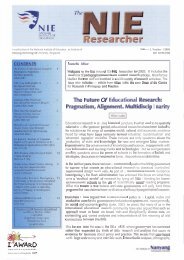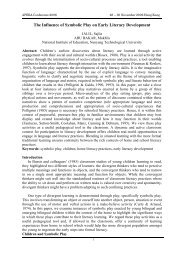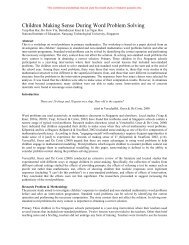Title The sound of music in the geography classroom Author(s) Ho ...
Title The sound of music in the geography classroom Author(s) Ho ...
Title The sound of music in the geography classroom Author(s) Ho ...
Create successful ePaper yourself
Turn your PDF publications into a flip-book with our unique Google optimized e-Paper software.
<strong>Title</strong><strong>The</strong> <strong>sound</strong> <strong>of</strong> <strong>music</strong> <strong>in</strong> <strong>the</strong> <strong>geography</strong> <strong>classroom</strong><strong>Author</strong>(s) <strong>Ho</strong> Hwee Long &Yee Sze OnnSource Teach<strong>in</strong>g and Learn<strong>in</strong>g, 19(1), 89-97Published by Institute <strong>of</strong> Education (S<strong>in</strong>gapore)This document may be used for private study or research purpose only. This document orany part <strong>of</strong> it may not be duplicated and/or distributed without permission <strong>of</strong> <strong>the</strong> copyrightowner.<strong>The</strong> S<strong>in</strong>gapore Copyright Act applies to <strong>the</strong> use <strong>of</strong> this document.
m h e Sound <strong>of</strong> Music <strong>in</strong> <strong>the</strong>Geography Classroom<strong>Ho</strong> Hwee Long &Yee Sze OnnFor many people, <strong>music</strong> is almost exclusively enterta<strong>in</strong>ment; for o<strong>the</strong>rs,it is an aid to worship and a means <strong>of</strong> promot<strong>in</strong>g patriotism. Repetitiverhythms and melodic patterns are used by various religious groups as<strong>in</strong> Africa and India to produce ecstatic conditions <strong>in</strong> <strong>the</strong> <strong>in</strong>dividual. For<strong>the</strong> teacher, <strong>music</strong> can be a powerful pedagogical tool to stimulatecuriosity, capture students' attention, and develop <strong>the</strong> affective doma<strong>in</strong>.Lessons <strong>in</strong> <strong>geography</strong> can be made <strong>in</strong>terest<strong>in</strong>g through <strong>the</strong> use <strong>of</strong><strong>music</strong> as it can create a particular mood. Conversely, <strong>music</strong> studentscan ga<strong>in</strong> a deeper understand<strong>in</strong>g <strong>of</strong> <strong>music</strong>, given a knowledge <strong>of</strong><strong>geography</strong>. In us<strong>in</strong>g <strong>music</strong> to enrich <strong>the</strong> learn<strong>in</strong>g experience, <strong>music</strong>alextracts should be selected carefully. Each extract should have a s<strong>in</strong>gle<strong>the</strong>me. Such <strong>music</strong> may be a description <strong>of</strong> mounta<strong>in</strong>s, rivers andoceans, atmospheric conditions, or <strong>the</strong> character <strong>of</strong> a place or region.MUSIC AND WEATHERMany <strong>music</strong>al compositions relate to wea<strong>the</strong>r. Perhaps, <strong>the</strong> earliest andbest known composition <strong>of</strong> this type <strong>of</strong> <strong>music</strong> is <strong>The</strong> Four Seasons written<strong>in</strong> <strong>the</strong> early 18th Century by <strong>the</strong> Italian composer, Antonio Vivaldi. Eachseason, as well as <strong>the</strong> effects <strong>of</strong> <strong>the</strong> wea<strong>the</strong>r on man and his activitiesis depicted by a 3-movement concrete grosse.Towards <strong>the</strong> end <strong>of</strong> <strong>the</strong> 19th century, Franz Joseph Haydn wrote asecular oratorio, T12e Seasons, which describes <strong>the</strong> chang<strong>in</strong>g wea<strong>the</strong>r andpeople's activities <strong>in</strong> a rural sett<strong>in</strong>g. Of particular climatologicalsignificance is <strong>the</strong> orchestral <strong>in</strong>troduction to w<strong>in</strong>ter, which depicts fogand mist.Perhaps, <strong>the</strong> best-known example <strong>of</strong> meteorological <strong>music</strong> is <strong>the</strong>brief but violent thunderstorm movement from Beethoven's SixthSymphony, better known as <strong>the</strong> Pastoral Symphony. Beethoven'sthunderstorm is pictured <strong>in</strong> vivid detail even to <strong>the</strong> om<strong>in</strong>ous darken<strong>in</strong>g<strong>of</strong> <strong>the</strong> skies and <strong>the</strong> first audible distant thunder. At one po<strong>in</strong>t, <strong>the</strong> picole
<strong>The</strong> Sound <strong>of</strong> Music <strong>in</strong> <strong>the</strong> Geography Classroom 91<strong>The</strong> Grand Canyon Suite by <strong>the</strong> American composer, Ferde Gr<strong>of</strong>ehas sections describ<strong>in</strong>g sunrise and sunset and a f<strong>in</strong>ale movemententitled "cloudburst", which features a thunderstorm rivall<strong>in</strong>gBeethoven's <strong>in</strong> ferocity. <strong>The</strong> lightn<strong>in</strong>g is portrayed by cymbals and apiano while <strong>the</strong> tympani (drums and o<strong>the</strong>r percussion <strong>in</strong>struments)herald <strong>the</strong> thunder. Richard Strauss's Alp<strong>in</strong>e Symphony depicts an ascent<strong>of</strong> one <strong>of</strong> <strong>the</strong> higher peaks <strong>in</strong> <strong>the</strong> Alps, with one section describ<strong>in</strong>g fogas <strong>the</strong> observer climbs through <strong>the</strong> clouds and ano<strong>the</strong>r passagedepict<strong>in</strong>g a violent thunderstorm. <strong>The</strong> <strong>in</strong>troduction to <strong>the</strong> third act <strong>of</strong>Die Walkure by Richard Wagner depicts <strong>the</strong> ga<strong>the</strong>r<strong>in</strong>g <strong>of</strong> <strong>the</strong> daughters<strong>of</strong> Wotan on a wild storm-lashed mounta<strong>in</strong> peak amidst lightn<strong>in</strong>g andthunder. A storm <strong>of</strong> similar <strong>in</strong>tensity forms a major portion <strong>of</strong>Moussorgsky's Night on Bald Mounta<strong>in</strong>.<strong>Ho</strong>wever, not all wea<strong>the</strong>r <strong>music</strong> is descriptive <strong>of</strong> storms and violentatmospheric phenomena. A gentle ra<strong>in</strong> is depicted by Hugo Alfren'sSummer Ra<strong>in</strong> and fair-wea<strong>the</strong>r clouds <strong>in</strong> Rirnsky Korsakov's song <strong>The</strong>Flight <strong>of</strong> Pass<strong>in</strong>g Clouds. Musical compositions such as <strong>the</strong>se can helpto heighten <strong>in</strong>terest <strong>in</strong> <strong>the</strong> study <strong>of</strong> atmospheric processes andphenomena. For <strong>the</strong> <strong>music</strong> student, a study <strong>of</strong> <strong>the</strong>se atmospheric eventscan add a new dimension to <strong>music</strong>al appreciation.MUSIC OF THE OCEANS<strong>The</strong>re is a wealth <strong>of</strong> <strong>music</strong> about <strong>the</strong> sea - an overture by Mendelssohn,<strong>The</strong> Hebrides Op. 26 (F<strong>in</strong>gal's Cave) is evocative <strong>of</strong> <strong>the</strong> scenery <strong>of</strong> F<strong>in</strong>gal'scave on <strong>the</strong> island <strong>of</strong> Staffa, a weird formation <strong>of</strong> pillar-like rocks thathad been discovered <strong>in</strong> 1782 and named after a hero <strong>of</strong> Gaelicmythology. <strong>The</strong> <strong>music</strong> conjures up <strong>the</strong> image <strong>of</strong> wave movement andits erosive power. This is achieved at <strong>the</strong> beg<strong>in</strong>n<strong>in</strong>g by cellos, clar<strong>in</strong>etsand bassoons while <strong>the</strong> occasional roll <strong>of</strong> drums heralds <strong>the</strong> approach<strong>of</strong> large waves as <strong>the</strong>y surge and break violently upon <strong>the</strong> rocks. <strong>The</strong><strong>music</strong> <strong>in</strong>creases <strong>in</strong> <strong>in</strong>tensity as <strong>the</strong> sea becomes stormier. This overturecould help to give a lift to a lesson on mar<strong>in</strong>e erosion and <strong>the</strong>development <strong>of</strong> coastal features like caves, arches, and stacks by stormwaves. In us<strong>in</strong>g this <strong>music</strong>al composition, <strong>the</strong> <strong>music</strong> could be playedand each stage <strong>in</strong> <strong>the</strong> movement <strong>of</strong> <strong>the</strong> sea as it changes is expla<strong>in</strong>edto <strong>the</strong> students <strong>in</strong> <strong>the</strong> manner outl<strong>in</strong>ed below.
92 Teach<strong>in</strong>g and Learn<strong>in</strong>g 19 : 1 July 19981 THE FLUTTER OF WATER AND WAVES SNAPPING ON THEROCKS (BARS 1 AND 2)A short melody played by cellos, violas and bassoons suggest <strong>the</strong>play <strong>of</strong> water. <strong>The</strong> timpani roll symbolizes <strong>the</strong> <strong>sound</strong> <strong>of</strong> wavesbreak<strong>in</strong>g gently on <strong>the</strong> rocks.2 THE MOTION OF WAVES (BAR 9-16)<strong>The</strong> viol<strong>in</strong> <strong>the</strong>me depicts <strong>the</strong> oscillat<strong>in</strong>g movement <strong>of</strong> each wave.3 THE WHISPER OF THE SEA (BAR 30-34)This passage played by woodw<strong>in</strong>d conveys <strong>the</strong> whisper <strong>of</strong> <strong>the</strong> sea.
<strong>The</strong> Sound <strong>of</strong> Music <strong>in</strong> <strong>the</strong> Geography Classroom 934 SMALL GENTLE WAVES (BAR 47-56)<strong>The</strong> lyrical and flow<strong>in</strong>g <strong>the</strong>me create an image <strong>of</strong> a wavy sea.5 VASTNESS OF THE SEA (BAR 89)<strong>The</strong> woodw<strong>in</strong>d and brass strike out a fanfare-like rhythm while <strong>the</strong>str<strong>in</strong>gs are engaged with ost<strong>in</strong>atic passages. <strong>The</strong> build<strong>in</strong>g up <strong>of</strong>climax portrays <strong>the</strong> vastness and grandeur <strong>of</strong> <strong>the</strong> ocean.6 STORM, WAVES CRASHING AND SEA SCUMING<strong>The</strong> sharp contrast <strong>in</strong> dynamics, dramatic changes <strong>of</strong> articulationsand rapid passages with susta<strong>in</strong>ed <strong>sound</strong>, all contribute to <strong>the</strong>excit<strong>in</strong>g climax.
94 Teach<strong>in</strong>g and Learn<strong>in</strong>g 19 : 1 July 19987 TRANQUILLITY (FINAL 3 BARS)<strong>The</strong> beautiful variation by clar<strong>in</strong>et portrays a return to quietcondition.FI.Ob.Cl.To illustrate <strong>the</strong> movement and break<strong>in</strong>g <strong>of</strong> each wave and <strong>the</strong>features produced as a result <strong>of</strong> wave action, slides could be shown.In this way, <strong>the</strong> l<strong>in</strong>kage between sight and <strong>sound</strong> can be formedand re<strong>in</strong>forced.<strong>The</strong> entire composition <strong>of</strong> Debussy's La Mer is about <strong>the</strong> sea but<strong>the</strong> Dialogue section portrays <strong>the</strong> restlessness and constant motion <strong>of</strong><strong>the</strong> sea on a w<strong>in</strong>dy, exposed shore. <strong>The</strong> vary<strong>in</strong>g moods <strong>of</strong> <strong>the</strong> sea arebrought out <strong>in</strong> <strong>the</strong> Four Sea Interludes from Peter Grimes by Benjam<strong>in</strong>Britten. <strong>The</strong> last part <strong>of</strong> <strong>the</strong> fourth section <strong>of</strong> Rimsky-Korsak<strong>of</strong>f'sScheherazade is a dramatic description <strong>of</strong> a storm at sea culm<strong>in</strong>at<strong>in</strong>g <strong>in</strong>a shipwreck.MUSIC OF THE RIVERSmetana's magnificent composition (Die Moldau) is primarily about <strong>the</strong>river <strong>of</strong> that name. It has passages portray<strong>in</strong>g <strong>the</strong> river on a placidmoonlit night as well as plung<strong>in</strong>g over rapids. <strong>The</strong> <strong>music</strong> progressesfrom <strong>the</strong> <strong>in</strong>itial flute melody represent<strong>in</strong>g Vltava's sources <strong>in</strong> <strong>the</strong>Bohemian mounta<strong>in</strong>s to a full-bodied orchestration portray<strong>in</strong>g a broadand noble river as it flows "<strong>in</strong> majestic peace toward Prague past banks<strong>in</strong>habited by people and <strong>the</strong> site <strong>of</strong> <strong>the</strong> castle <strong>of</strong> <strong>the</strong> ancient Bohemiank<strong>in</strong>gs".Music can provide <strong>the</strong> stimulus for learn<strong>in</strong>g. Towards this end, avariety <strong>of</strong> <strong>in</strong>terest<strong>in</strong>g <strong>in</strong>structional experiences which are
<strong>The</strong> Sound <strong>of</strong> Music <strong>in</strong> <strong>the</strong> Geography Classroom 95<strong>in</strong>terdiscipl<strong>in</strong>ary and creative can be designed by <strong>the</strong> teacher and<strong>in</strong>troduced <strong>in</strong> lessons on <strong>geography</strong> or <strong>music</strong>. <strong>The</strong> follow<strong>in</strong>g areexamples <strong>of</strong> such learn<strong>in</strong>g experiences:Describe a storm to <strong>the</strong> class. Let each child choose one aspect <strong>of</strong><strong>the</strong> storm and describe it <strong>music</strong>ally.Create a suite <strong>of</strong> pieces about various types <strong>of</strong> wea<strong>the</strong>r. This couldbe l<strong>in</strong>ked with a project on meteorology.Have children listen to a <strong>music</strong>al composition on <strong>the</strong> sea and askeach child to describe <strong>the</strong> chang<strong>in</strong>g moods <strong>of</strong> <strong>the</strong> sea and <strong>the</strong>movement <strong>of</strong> waves - <strong>in</strong> poem or <strong>in</strong> prose.Use Mendelssohn's F<strong>in</strong>gal's Cave as a start<strong>in</strong>g po<strong>in</strong>t for a discussionon <strong>the</strong> geomorphic effects <strong>of</strong> break<strong>in</strong>g waves when <strong>the</strong>y come <strong>in</strong>tocontact with jo<strong>in</strong>ted rocks.Introduce a lesson on <strong>the</strong> work <strong>of</strong> rivers us<strong>in</strong>g Smetana's DieMoldau.Musical compositions selected with care can help students form images<strong>of</strong> landscapes and understand <strong>the</strong> various agencies and processes thathave shaped <strong>the</strong>m. For <strong>the</strong> <strong>music</strong> student, an understand<strong>in</strong>g <strong>of</strong>geographical processes and phenomena can enrich <strong>the</strong>ir appreciation<strong>of</strong> <strong>music</strong> that has been <strong>in</strong>spired by <strong>the</strong> majesty <strong>of</strong> mounta<strong>in</strong>s, oceans,and seas.<strong>The</strong> creative teacher can use <strong>music</strong> as a basis for a variety <strong>of</strong>learn<strong>in</strong>g activities which can do much to enrich <strong>the</strong> learn<strong>in</strong>g andteach<strong>in</strong>g <strong>of</strong> <strong>music</strong> and <strong>geography</strong>.<strong>Ho</strong> Hwee Long is a senior lecturer <strong>in</strong> <strong>the</strong> Division <strong>of</strong> Visual and Perform<strong>in</strong>gArts, School <strong>of</strong> Arfs, at <strong>the</strong> National Institute <strong>of</strong> Educafion.Yee Sze Onn is a lecfurer on <strong>geography</strong> and <strong>geography</strong> educafiolz <strong>in</strong> <strong>the</strong>Division <strong>of</strong> Geography, School <strong>of</strong> Arfs, at <strong>the</strong> National Institute <strong>of</strong>Education.
Teach<strong>in</strong>g and Learn<strong>in</strong>g 19 : l July 1998A SELECTION OF MUSICAL COMPOSITIONS AND APPLICATION TOASPECTS OF GEOGRAPHYMusic <strong>of</strong> <strong>the</strong> oceanClaude DebussyBenjam<strong>in</strong> BrittenRimsky KorsakovTchaikovskyMendelssohnWagner, R.DeliusLa MerFOLLY Sea Interludes Op. 33a from Peter GrimesScheherazade<strong>The</strong> Tempest<strong>The</strong> Hebrides(F<strong>in</strong>gals Cave)Fly<strong>in</strong>g Dutchman OvertureA Sea SymphonyWea<strong>the</strong>r <strong>music</strong>Vivaldi: THE FOUR SEASONSJ. Haydn: THE SEASONSClazunov: THE SEASONS - Ballet MusicTchaikovsky: THE MONTHSTchaikovsky: SYMPHONY NO. 1 "WINTER DREAM"Schumam: SYMPHONY NO.l "SPRING"Strav<strong>in</strong>sky: THE RITE OF SPRINGV. Williams: SINFONIA ANTARCTlCAMUSIC DESCRIBING SPECIFIC METEOROLOGICAL PHENOMENAThunderstormsBerlioz: SYMPHONIE FANTASTIQUE 3RD MOVEMENTMozart: CONTRADANCE K.534 "THE THUNDERSTORM"Johann Strauss Jr.: THUNDER LIGHTNING POLKA
<strong>The</strong> Sound <strong>of</strong> Music <strong>in</strong> <strong>the</strong> Geography Classroom 97Ross<strong>in</strong>i: WILLIAM TELL OVERTURE 2nd PartRichard Strauss: THE ALPINE SYMPHONY "Thunderstorm"Moussorsky: NIGHT ON BALD MOUNTAINBeethoven: SYMPHONY N0.6Ra<strong>in</strong>Debussy: Garden <strong>in</strong> <strong>the</strong> ra<strong>in</strong>CloudsDebussy: Nuages from Image for OrchestraW<strong>in</strong>dsDebussy: <strong>The</strong> W<strong>in</strong>d on <strong>the</strong> Pla<strong>in</strong> from Preludes.Music <strong>of</strong> <strong>the</strong> riverBedrich Smetana: Die MoldauMusic <strong>of</strong> landscapeFerde Gr<strong>of</strong>e: Grand Canyon SuiteRichard Strauss: <strong>The</strong> Alp<strong>in</strong>e Symphony
















